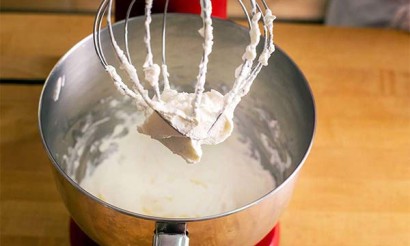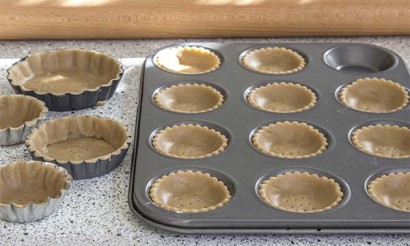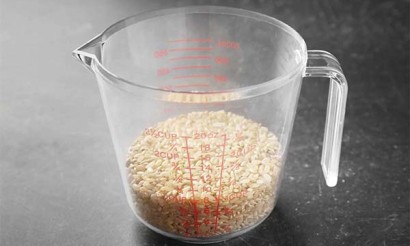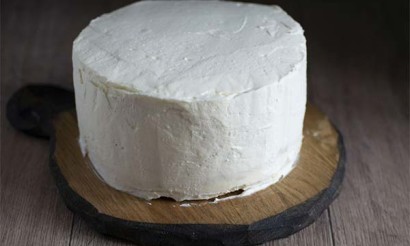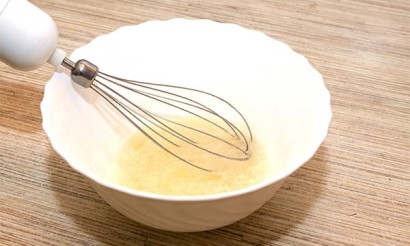Bugs in grits and flour: how to get rid of pests in the kitchen
Bugs in grits - a nuisance, which at least once in life every housewife has faced. Such parasites destroy supplies and can cause an allergic reaction if you accidentally eat them together with cooked grits. There are several ways to combat them, which will help to destroy the insects and save the rest of the stock.
- Causes of insects in the kitchen
- What pests breed
- Bread grinder
- Nutcracker
- Food moth
- Red flour beetle
- Weevil
- What are the dangers of bugs in cereals?
- Is it possible to eat infected grits
- Traditional methods of getting rid of the bugs in cereals
- Chemical methods and store remedies
- Preventive measures
- How to store cereals to avoid bugs
Causes of insects in the kitchen
Insects that breed in cereals, tend to settle where they will be comfortable, nourished and warm. That's why pasta, flour, breadcrumbs, bread, rice and various concentrates lure to themselves a large number of different pests. As a result, the food supply becomes unfit for consumption.
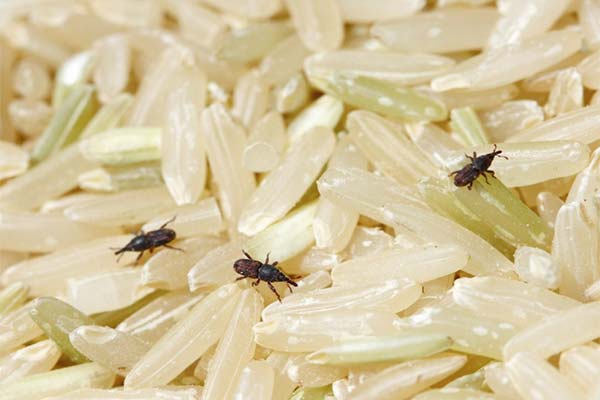
Once in one bag or jar of cereal, the bugs begin to multiply rapidly. As a result, they can be spotted not only in the kitchen or pantry, but even in other rooms.
Sources of infestation:
- Grocery store. Even inside hermetically sealed packages there can be pests. The bugs get in at the factory when the product is being sorted or in the room where the product was sold if the storage conditions are not met.
- Neighbors. Very often the cause of parasites in cereals are neighbors. Insects enter the apartment through the ventilation system. Once in favorable conditions, they begin to multiply quickly and spread throughout the apartment.
- Textiles. It is not uncommon for bugs to breed in textiles and wooden items. Therefore, after buying towels or bed linen, it is important to wash them thoroughly first.
The presence of even a single beetle is a reason for treatment. It is important to constantly monitor the condition of the kitchen by regularly treating cereals and storage containers. Pay special attention to pet food - parasites are very fond of them.
This is interesting! It is not uncommon for bugs to live in bakeries and bakeries. It is warm, nourishing, and quite humid there. In urban apartments, they enter by crawling into the packaging of bread and other baked goods.
What pests breed
In cereals most often breed bugs of the following species:
Bread grinder.
It can be distinguished by its long oval body. It is 3 to 5 mm long. It is red in color and multiplies very quickly, so it is not so easy to get rid of it. They mainly breed in rice, barley or buckwheat. It likes tea, tobacco and spices. Also often lives in baked goods.
Nutcracker.
The parasite reaches 6 mm in length, has an elongated body, and is brown in color. It multiplies quickly and can infest a large area of the kitchen or pantry in a short time. It often lives in flour, where it lays eggs. They do not differ in color from it, so they are not easy to detect. Also likes oat or semolina.
Food moths
It gets its name from the fact that it resembles a moth or a butterfly. The insect grows up to 1 cm in length. Due to its not pronounced color, it is perfectly camouflaged. They reproduce by laying up to 50 eggs per day, which makes it very difficult to eradicate the moths. Detectable by the presence of cobwebs that weave larvae. It feeds on all foods and is not fussy about food.
Ginger mealworm.
These bugs are small, up to 2 mm long. They usually live in places where it is warm and humid. Less common insect, as it lays eggs only up to 7 times a year. Feed on cereals that have already deteriorated due to improper storage. In the absence of the necessary conditions, it dies.
Weevil
A fairly common black-colored parasite. It reaches 5 mm in length. It is easy to distinguish it from other bug species - it has an elongated spout, similar to a trunk. It is undemanding and omnivorous.
It is important to determine the type of bug in order to choose the right remedy for its extermination.
What are the dangers of bugs in cereals?
It is impossible to get rid of bugs by sifting and sifting, so it is not recommended to use such cereals. The danger lies in the following:
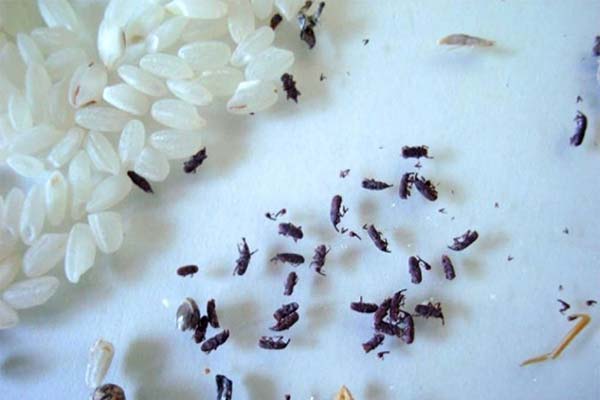
- Poisoning. People with weakened health, chronic diseases and small children at the use of such groats intoxication occurs. It is expressed in the form of an increase in body temperature, the occurrence of painful sensations in the abdominal area, nausea and vomiting.
- Disturbance of the digestive process. Getting into the body, residual products of parasites lead to irritation of the intestinal mucosa.
- Allergic reaction. Often, after the use of previously contaminated cereal rash, redness of the skin, runny nose and increased lacrimation occur.
That is why you should not cook cereals where there were bugs even after treatment.
Can I Eat Contaminated Cereal
It is not recommended to eat infected grits. Not everyone can overcome the psychological factor. It is not always pleasant to eat porridge or soup, knowing that the products had parasites.
It is important: In order to save groats from bugs, the bulk products should be reconsidered (sift flour through a fine sieve) and calcined in a heated to 50 degrees oven. This will allow you to get rid of the remaining parasites and products of their life.
Folk methods of getting rid of the bug in cereals
It is possible to get rid of parasites, which have become established in loose products, with the help of folk methods. All of them are quite effective. Insects are known to be afraid of herbs with a strong aroma: lavender, laurel leaf, wormwood. Garlic or nutmeg can be used. They are placed on shelves, in the pantry and changed periodically.
In case the parasites were infested a long time ago and have already managed to settle in the kitchen, use special traps. To do this, you need:
- Thoroughly mix powdered sugar and borax in equal quantities.
- Spread the mixture in the lids in small quantities.
- Place them in different corners of the kitchen cabinets.
Important! The bait should be constantly checked and the mixture should be refilled as necessary. Over time, the vermin will die completely.
Chemical methods and store remedies
Sometimes it is impossible to get rid of bugs in grits with the help of folk remedies. In this case, store remedies will come to the rescue. They help even with severe lesions.
Before using chemical solutions, it is necessary to know the safety rules:
- Treatment should be carried out with the use of personal protective equipment. This is a mask and gloves. They will help protect the skin and mucosa of the eyes and respiratory organs from the harmful effects of chemicals.
- Disinfection is carried out in the absence of children and pets.
- The room after treatment should be aired out.
- After 2-3 days, repeat the procedure to consolidate the result.
To destroy the parasites affecting the groats, the means, which include chlorine, will help. This is "Belizna" or "Domestos". With their help, wipe all surfaces in the kitchen, and after 1-2 hours air them out.
Also effective preparations against bugs in cereals are:
- "Pyrethrum". It is sold in powder form. It is poured on the shelves where cereals are stored. After a couple of days, the parasites will completely disappear. The drug is safe for children and animals.
- "Antibug". The product is intended for the treatment of wooden surfaces. Due to its properties, the product will destroy insects and prevent their appearance in the future. It should be used with caution as it causes severe irritation or chemical burns if it comes into contact with mucous membranes or skin.
- "Lavin Fireproofing. Used in the presence of bread grinder or mealworms. A respirator should be worn before use to protect mucosa and respiratory organs. The fumes of the product are dangerous to the body.
- "Rogneda. Preparations of this company are known for their properties to quickly and effectively destroy not only bugs in grits, but also other insects, such as cockroaches, ants, flies.
All food and utensils should be put away, and spoiled grits should be thrown away. You should ventilate the kitchen or pantry only after 1-2 hours, so that the preparation has time to work.
Preventive measures
In order to prevent the appearance of bugs in cereals, it is recommended to observe simple preventive measures:

- When buying in the store, carefully inspect the product, check the tightness of the package.
- Do not buy too much cereal. Do not stock up on cereals. Prolonged storage, especially if the storage conditions are wrong, leads to the emergence of parasites.
- Keep granular products in tightly closed containers. A glass jar that is impervious to moisture while not preventing ultraviolet rays from penetrating would be ideal.
- Conduct regular revisions. Anything that has already gone bad or is suspicious should be thrown out without regret.
- Keep the kitchen clean and tidy and constantly clean it with damp cloths. The room needs constant airing, because high humidity causes parasites to multiply quickly.
- Spread bay leaf or nutmeg on the shelves. They will deter uninvited guests.
It is important to inspect and rinse groats thoroughly before cooking them. Following simple rules will help reduce the risk of insects in bulk products.
How to store cereals to avoid bugs
In addition to compliance with preventive measures, it is also recommended to properly store cereals. The rules are simple:
- Do not put all bulk products in one place.
- The ideal storage location is a glass container with a tightly closing lid.
- Clean the shelves once a week. Anything that is accidentally spilled should be put away.
- Regularly check loose foods for infestations. If insects are found, take all steps to remove them before the parasites spread.
- After buying flour, rice, buckwheat, and other cereals, it is recommended to put them in the freezer for 24 hours. This will help to disinfect them.
- Dried fruits, nuts and legumes are better stored in the refrigerator. They have a long shelf life and are often prone to bugs.
- The kitchen should be constantly ventilated.
- If bugs have already appeared, it is better to put a bay leaf or a garlic clove in a container with the product to prevent them.
Bugs in grits or flour are not uncommon. They get into it with other products, brought from the store or from neighbors. It is easy enough to get rid of them if you take measures immediately after detection. You can use folk methods or chemical preparations. You should also follow preventive measures and properly store cereals to avoid re-infestation of products.
«Important: All information on this site is provided for informational purposes only. for information purposes. Ask for advice before applying any recommendations. specialist before applying any of the recommendations. Neither the editors nor the authors shall be held liable for any possible harm caused by materials."


